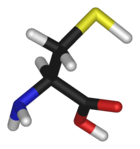amino acids
Additional amino acids essential to children: histidine and arginine.
• amino acid chart • alanine • arginine • asparagine • aspartic acid • cysteine • glutamic acid • glutamine • glycine • histidine • isoleucine • leucine • lysine • N-formylmethionine • methionine • phenylalanine • proline • serine • threonine • tryptophan • tyrosine • valine
External links: Alanine Arginine Asparagine Aspartic acid Cysteine Glutamic acid Glutamine Glycine Histidine Isoleucine Leucine Lysine Methionine Phenylalanine Proline Serine Threonine Tryptophan Tyrosine Valine Essential amino acid Protein Peptide Genetic code Isoleucine and valine biosynthesis Leucine biosynthesis





































































